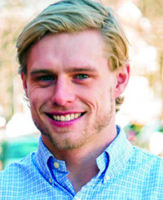My Story: Bryce Lawlor, CSP

My father, an electrical contractor, and my mom, in insurance, know all too well what workplace safety and health mean. I had always been a worrywart growing up. Always yelling at my dad for being too high on a ladder, even if he was just three steps up – it always made me nervous. Always marveling at high-rise construction sites. Always scared I was going to see someone fall while walking across those beams they were putting together.
It was my parents who suggested I pursue a degree in something called occupational safety and health. I had never heard of it. I landed at Keene State College in Keene, NH. I enrolled in occupational safety and health sciences studies. I thought it was interesting, so I gave it a shot. At that point, I hadn’t a clue what I wanted to do, but thought the program fit me well.
Reflecting back on it now, in school, it’s very hard to understand the importance of this profession without being fully immersed in it. I found that immersion comes not from a job or a role, but the people you work with. This career isn’t about regulatory compliance – checking off some box to prove you did your job for the day so you can go home. This job means everything. Not to you – to them. To your co-workers, possibly those you call friends. To those on the front line making the product, building the building, welding the tool, etc. Our workforce.
I think we fall victim to why we are interacting with these people in the first place. A person we are interviewing as a result of an incident. Someone we are performing air sampling on. Someone we are observing in looking at their station for ergonomic improvements. It’s not until you get to know these people that our mindset changes, or should change, for that matter.
I was talking with a colleague in the facilities group the other day. He was sharing with me his plans for going fishing with his son on the weekend. Unfortunately, the reason we started talking in the first place was me observing his lack of fall protection while working near a roof’s edge. It pains me to know that I had failed him. I had failed to properly train him. I had failed to communicate that hazard. I had failed to ensure systems were in place to eliminate that hazard. I’ve come to realize that when you strip away all the programs, textbooks, technical manuals and safety jargon, the root of our day is our people. It’s my job to identify failures and correct them, even if they are on me. It’s my job to take ownership, take accountability of where we, or the company, have failed in keeping that person safe. Always keeping paramount our pursuit in improving a safer workplace.
I urge everyone to stay mindful of why we got into this profession. Maybe it wasn’t for the same reasons in which motivate you today. We can easily get caught up in the day to day. But take a breath. Talk to people. Understand it’s not about you or the company or your checklist – it’s about them. It will always be about them, and if we stray away from that, then we have failed. And in this profession, failure is a means of life and death – and failure is not an option.
 Bryce Lawlor, CSP
Bryce Lawlor, CSPEHS Engineer
Raleigh, NC
What’s your story?
Email us at [email protected] with the subject line “My Story.” You may be featured in an upcoming issue of Safety+Health.
Post a comment to this article
Safety+Health welcomes comments that promote respectful dialogue. Please stay on topic. Comments that contain personal attacks, profanity or abusive language – or those aggressively promoting products or services – will be removed. We reserve the right to determine which comments violate our comment policy. (Anonymous comments are welcome; merely skip the “name” field in the comment box. An email address is required but will not be included with your comment.)

